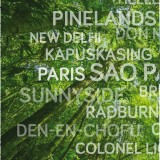Hello! It seems spring has sprung (ish). It's cold and wet while I write this but the blossom is out and new green leaves are making an appearance: always a welcome transition after the long darkness of winter.
I have been away for much of April in Australia, and while there I was really pleased to be able to see some academic colleagues I've known for many years, with whom I share garden cities interests. In particular it was great to catch up with Emeritus Professor Stephen Hamnett, the eminent planning scholar, who has written extensively about cities including the garden variety. Stephen was just in the throes of preparing a presentation for a conference which he said was bringing together his research passions including garden cities. I'm very much looking forward to reading that in due course. In the meantime I would highly recommend taking a look at one of Stephen's excellent books with another great planning scholar, Rob Freestone, The Australian Metropolis: A Planning History which has some really fascinating Garden City related aspects.
Being in Australia of course made me think about the way Garden City ideas developed and took on their own particular place specific forms there. I spent some time in Canberra which demonstrates Garden City influences on a grand scale as part of Walter Burley Griffin's City Beautiful inspired plan. The influence of South Australia's parkland towns on Ebenezer Howard's ideas for the Garden City is possibly not as well known or widely acknowledged as it might be but it was a significant inspiration, as Prof Hamnett has shown. Numerous such parkland towns were planned for South Australia in the 19th century, but quite a few of these settlements were never built or only partially completed. It's not really surprising given their extremely isolated and climatically challenging proposed locations, on or beyond the edge of what could ever be inhabitable areas in an agrarian sense. Perhaps they were a testament to the triumph of hope over experience. A less charitable analysis would see them as part of a colonising project to claim ownership over indigenous space, displacing traditional owners.
Adelaide, the capital of South Australia, is famously a parkland 'greenbelt' city (with some heritage listed garden suburbs too like Colonel Light Gardens). Walking through its parklands today I was struck by how gorgeous some of these green spaces remain, with mature tree plantings giving a park setting to special buildings like the cathedral, and the chance to enjoy superb vistas looking down from North Adelaide to the main city grid. The parklands are also the home to a really wonderful Botanic Gardens and offer some very moving memorial gardens, characteristic olive groves and more bushland-like settings here and there. I was less thrilled to see how much of the 'green' part of the greenbelt along the northern edge of the city square has become a repository for a series of (in my eyes) uninspiring architectural experiments. Where there was largely once a green landscape-based counterpoint to the city's built form, today in parts it looks more a jumble of object buildings and hard spaces. It was sad to see how far these sections of the parklands have now been allowed to depart from the original - and to me still highly valuable - original conception.
Since returning this week it's been a pleasure to help host a delegation to the International Garden Cities Institute of built environment and development professionals from Bluetown Greentown, a leading Chinese firm involved in developing new settlements in China. I was privileged to have the opportunity to meet this fascinating group and speak to them both in Old Hatfield and at the Institute in Letchworth, about aspects of garden city planning and design including in relation to food (a special interest of mine) and engaging with communities in garden city contexts. I do hope that added something useful to their very full schedule.
Also this week the finishing touches were made to a really lovely Think Piece by Professor Dong-Ho Shin from Hannam University in Korea. Prof. Shin has recently visited us here in Letchworth and very kindly agreed to record his impressions of the garden city for us in the form of this account of his walks around the Garden City. I hope you will enjoy as much as I did his refreshing take on the Garden City and his intriguing comments in relation to Garden Cities within the Korean planning and development system. That Think Piece can be read here.
Also this month I have been discussing with our terrific PhD scholar Amelie Andre her progress in mapping food spaces and business in the City. Amelie is making excellent progress in exploring the food economy of Letchworth Garden City and should be able to offer some very useful practical insights in the next few months.
Finally, do look out for the first major exhibition about the Letchworth architect Barry Parker that is starting next week (from Friday 4 May 2018 to Sunday 15 Jul 2018) at the Broadway Gallery in Letchworth Town Centre. As the Gallery notes Barry Parker: Architecture for All is "celebrating Parker as the architect of Letchworth Garden City, and an unsung hero of the Arts and Crafts movement. This will be the first exhibition to examine Parker’s contribution to architecture, showcasing some of the 4,500 objects from the Parker Collection, including architectural plans and drawings, photographs, furniture and fine art." It is also going to be possible to visit Parker’s drawing offices at the International Garden Cities Exhibition which is a beautiful Arts & Crafts thatched building just 5 minutes’ walk from the Gallery. Do go along is you can - it's going to be fantastic.
Well that is all for this month. I'll check in again in May.
Susan Parham
April 27th, 2018

